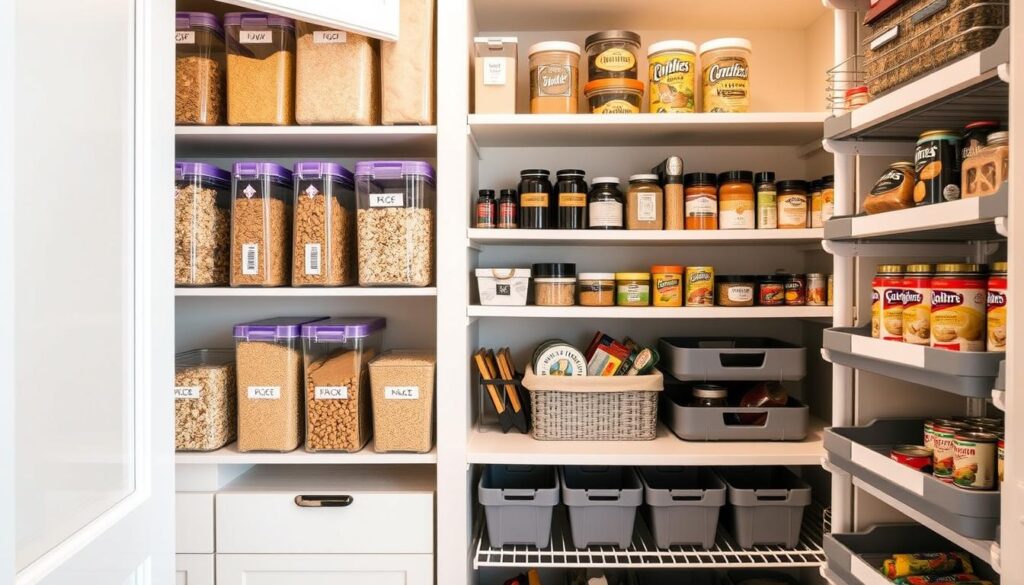Ever thought a tidy pantry could change your cooking time? Many don’t see how kitchen pantry hacks affect their day. Yet, the right methods can change how you prep meals and shop for groceries.
This article shares pantry organization tips that make your space neat and efficient. You’ll learn how to declutter and keep your pantry calm. This way, you’ll feel more creative and less stressed.
Key Takeaways
- Maintaining a consistent pantry organization system can prevent mess and disruption.
- Choosing the right containers enhances storage efficiency and visual appeal.
- Regular upkeep involves minimal effort, requiring only a few refills weekly.
- Utilizing vertical space with shelf risers can significantly boost storage capacity.
- Labeling and clearing expired items can reduce food waste and improve inventory tracking.
Why Organizing Your Pantry Is Essential
A disorganized pantry can cause a lot of stress when you’re cooking. It’s hard to find what you need, making things feel overwhelming. Many people end up buying the same things twice, with about 30% of shoppers doing this.
Using clear bins and containers helps a lot. It makes it easier to see what you have, cutting down on buying the same things by 50%. An organized pantry saves time, too. You can find what you need 20% to 30% faster, saving about 10 hours a year.

Organizing your pantry does more than save time. Families who organize their pantry well are happier with their kitchen, feeling 45% more organized. Labeling items helps everyone understand where things go, reducing confusion by 50%. In short, a well-organized pantry makes cooking easier and more enjoyable.
The Benefits of a Well-Organized Pantry
Organizing your pantry makes cooking faster and more fun. It can cut down meal prep time by up to 30%. This means you can quickly find what you need, making cooking easier.
Disorganized pantries often lead to buying things you already have. Over 60% of people have bought pantry items they already had. A tidy pantry saves about 20% on groceries by avoiding these duplicate buys.
Organizing your pantry also helps reduce food waste. By keeping track of when things expire, you can use older items first. This can cut down food waste by up to 50%.
When your pantry is organized, planning meals becomes easier. Clear labels make it 80% easier to see what you have. This encourages healthier eating and more creativity in the kitchen.
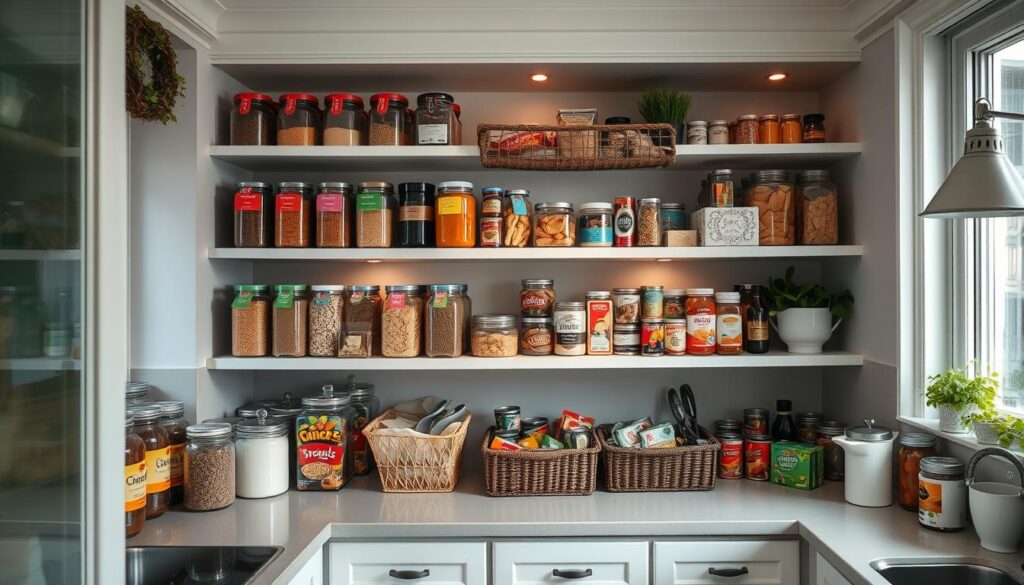
Regular pantry checks also save time. 45% of families say it helps avoid unnecessary trips to the store. An organized pantry makes your kitchen look better and reduces stress while cooking.
Having a place for everything you use often saves time. It can cut down meal prep by 40%. Using the FIFO method helps avoid expired food, making your pantry stock last longer.
Start with a Clean Slate: Decluttering Your Pantry
Decluttering your pantry is key to a tidy space. Start by checking each item carefully. This means finding expired items and deciding what you really need.
Many people get frustrated with messy pantries. It makes finding ingredients hard. By decluttering, you create a space that’s easy to use.
Identifying Expired and Unwanted Items
First, sort out expired items. Old food wastes space and leads to waste. In fact, 20% more food is wasted in messy pantries.
Set aside time to check expiration dates. Toss out anything stale or unwanted. This saves families about $300 a year by cutting down on buying too much.
Creating a Food Inventory
Once expired items are gone, make a food inventory. This list keeps track of what you have. It stops you from buying too much.
Studies show families that do this plan meals better and save time. A clear inventory makes your pantry more useful. It helps you only buy what you need, reducing waste.
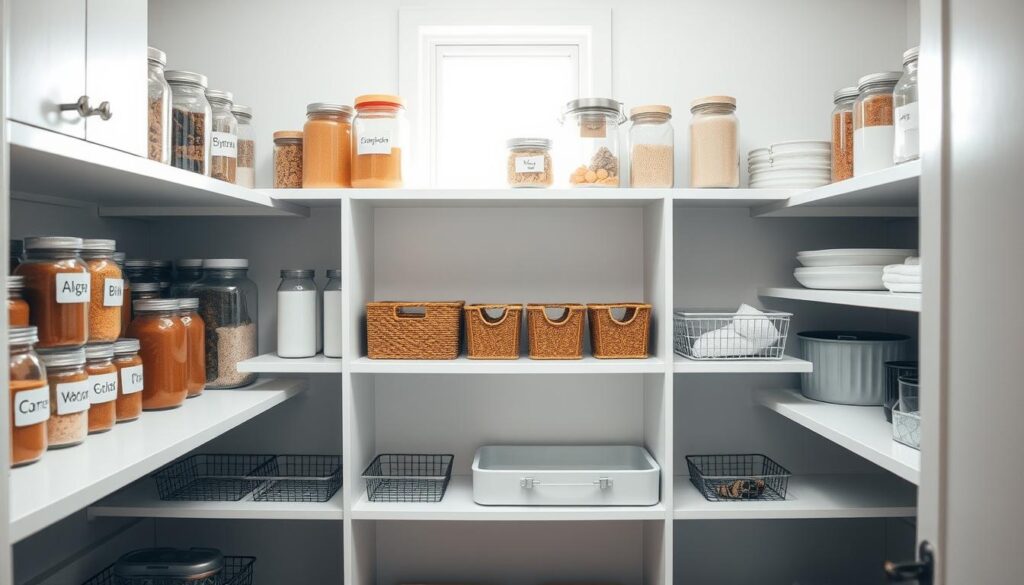
Planning Your Pantry Layout
Creating a good pantry layout needs careful planning and smart organization. A well-designed pantry makes things easier to find and use. It’s important to measure your shelves and pick the right container sizes for your needs.
Measuring Shelf Space and Container Sizes
Before you start arranging your pantry, measure your shelves carefully. Knowing the exact sizes helps you choose containers that fit just right. When thinking about kitchen pantry organization hacks, remember these tips:
- Use clear containers to see what you have, which helps avoid buying things twice.
- Add shelf risers to make more room on your shelves, increasing storage.
- Put hooks on cabinet walls to hang things, saving space on shelves and counters.
- Choose turntables for spices to make them easy to reach and use.
- Use stackable bins with open fronts for snacks to see what you have and grab it easily.
By measuring your shelves well, you can arrange items by how often you use them. This makes finding things quicker and uses every part of your pantry. Keep your most-used items at eye level and use a consistent labeling system for easy finding.
Sketching out your pantry layout helps you make changes based on what you have. A well-thought-out pantry layout improves both its function and looks, making your kitchen a pleasure to be in.
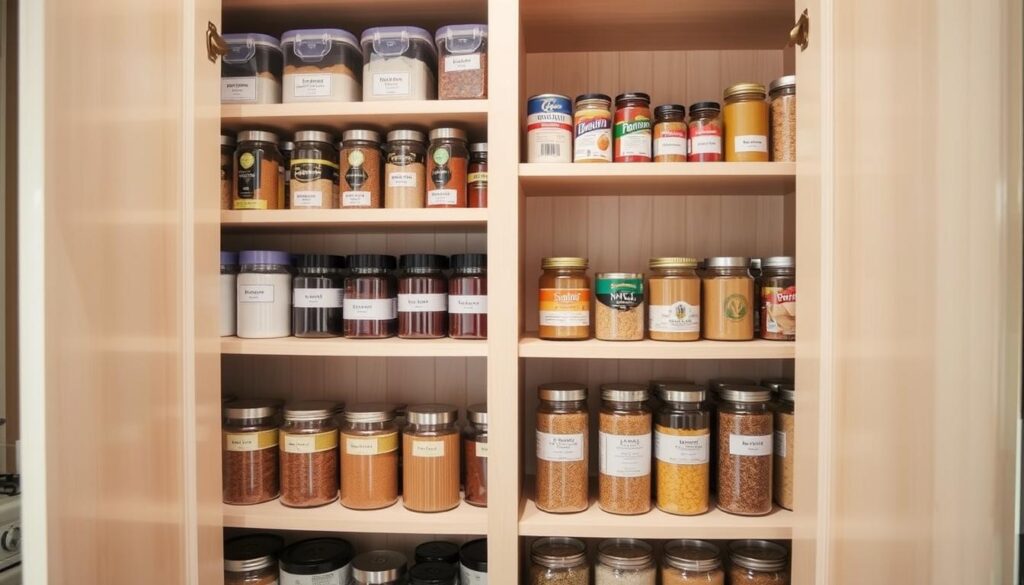
Kitchen Pantry Organization Hacks
Effective kitchen pantry hacks can make cooking easier and meals quicker to prepare. A few smart tips can turn your pantry into a well-organized space. Start with clear storage containers. They help you see what you have, saving time.
Organize items by how often you use them. Put the most used items at eye level for easy access. This strategy is based on retail ideas that 70% of shoppers follow. Also, use the FIFO method to avoid wasting food.
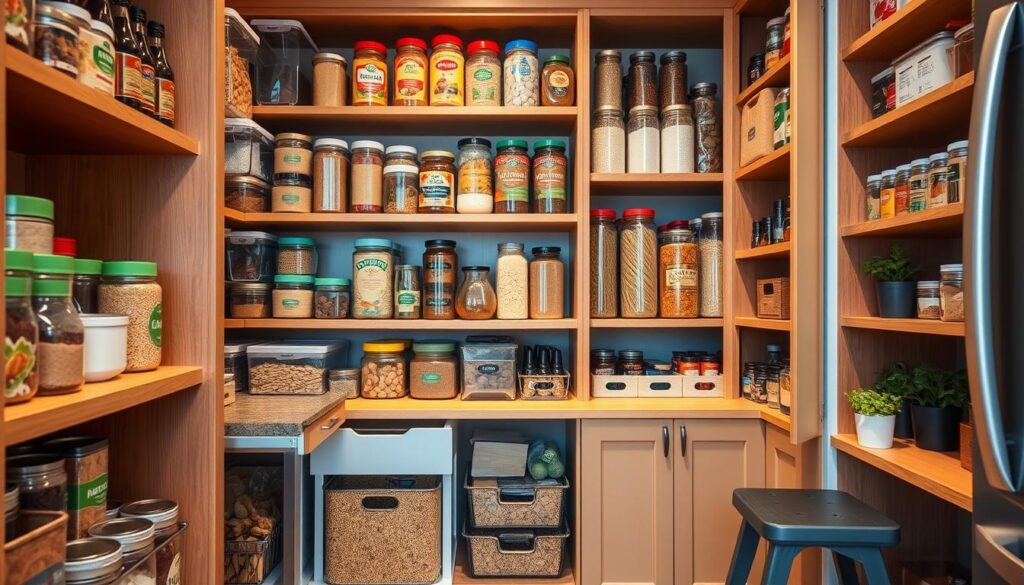
Turntables and tiered shelving can make items 60% more accessible. They help you use space better and avoid missing items. Shelf risers add another 50% of space, making your pantry more organized.
Grouping similar items together saves time. Organize snacks or baking supplies in sections. Be creative with jars for dry goods to cut down on plastic waste. These hacks make cooking more efficient and fun.
Choosing the Right Containers for Your Pantry
Choosing the right containers is key for a well-organized pantry. You need to decide between open and airtight containers. Open containers make it easy to grab what you need, while airtight ones keep food fresh. The right mix helps you find what you need fast and keeps food fresh longer.
Open vs. Airtight Containers
Think about what you store when choosing between open and airtight containers. Open containers like baskets or jars are great for snacks and staples you use often. They let you see what’s inside and grab it quickly. On the other hand, airtight containers protect grains, cereals, and baking supplies from moisture and pests. Mixing both types makes your pantry both accessible and fresh.
The Importance of Clear Storage Options
Clear storage options make it easy to see what you have. This can cut down your search time by 30%. Clear bins and jars let you see what’s inside, making it simple to check what you have. Clear storage makes your pantry not only organized but also looks good.
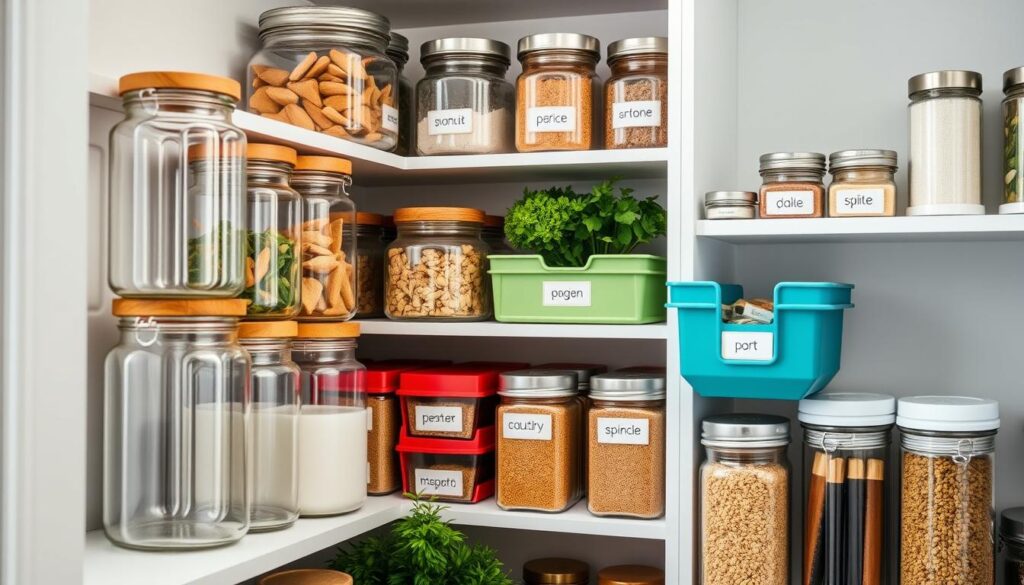
Maximizing Vertical Space in Your Pantry
Maximizing vertical space in your pantry can change your kitchen. Smart pantry shelving ideas help you store more without clutter. You’ll find everything easily, making cooking and meal prep better.
Using Shelf Risers for Extra Storage
Shelf risers are great for doubling your shelf space. They lift items, making it easy to reach the back. Shelf risers help use vertical space well and keep items together.
This makes things easier to find and keeps your pantry organized. You’ll quickly find what you need.
Incorporating Tension Rods for Baking Sheets
Tension rods are a clever way to store baking sheets and cutting boards. They free up shelf space for other things. By using rods vertically, you store essentials without losing access.
These ideas help you organize your pantry in creative ways. They fit your specific needs perfectly.
Utilizing Unused Pantry Spaces
Start by finding unused areas in your pantry to make more space. These spots can turn into useful parts of your pantry. They help make your pantry more organized and efficient.
Back-of-the-Door Storage Solutions
Adding storage to the back of your pantry doors is a smart move. It’s perfect for small items like spices, condiments, and snacks. These items can clutter your shelves if not stored properly.
Custom racks or shoe organizers can add up to 40% more space. Using this vertical space saves room and keeps items you use often within reach.
Using Top Shelf for Infrequent Items
The top shelf of your pantry is often unused. It’s great for storing items you don’t use daily. Seasonal products or larger kitchen tools fit well here.
By storing these items here, you clear up space on lower shelves. This makes your pantry look more organized. It also makes cooking 30% more efficient, making meal prep smoother.
Organizing by Zones for Easy Access
Setting up specific zones in your pantry can make cooking easier and faster. By using smart pantry tips, you can have areas for snacks, baking, and canned goods. This way, you can find what you need quickly and prepare meals more efficiently.
Creating Sections for Snacks, Baking Supplies, and Canned Goods
Having different zones in your pantry makes it simpler to find what you need. For snacks, use a door organizer for quick grabs. For baking, group items like measuring cups and flour together. Canned goods should have their own spot, using stair-step shelves to see everything.
This setup helps you use what you have and reduces waste. It makes your pantry look good and work better.
The Benefits of Grouping Similar Items
Putting similar items together is key to a well-organized pantry. It makes cooking easier and helps with meal planning. Dry ingredients in clear containers help you keep track of what you have.
Studies show that organized pantries lead to better shopping and save time. You might spend 10-15 minutes less on meal prep.
Labeling Your Pantry for Clarity
Having a clear pantry makes meal prep easier. Labeling items helps everyone find what they need fast. This turns a messy pantry into a well-organized space.
Uniform labels are key to keeping things tidy. They make it simple for family members to check what’s available. This helps with cooking tasks.
Creating Uniform Labels for Storage Containers
Creating a uniform labeling system boosts pantry efficiency. Here are some tips:
- Choose a consistent style: Pick a font and color that match your kitchen.
- Include essential information: Label each container with what’s inside, its size, or when it expires.
- Utilize quality materials: Use durable toner and sticker paper, like Avery Clear Sticker paper, for lasting labels.
- Prioritize legibility: Labels should be easy to read from afar.
- Consider visual aids: Add icons or images for kids to recognize items quickly.
Creating a labeling system saves time and money. About 80% of families see less food waste and lower grocery bills. It makes meal planning and shopping easier. Plus, it helps everyone work together in the kitchen.
DIY Pantry Organization Ideas
Looking for ways to organize your pantry can make it both useful and pretty. DIY projects let you use everyday items in new ways. You can make your own shelves or use containers to save money and show off your style.
Repurposing Containers for Storage
Using containers you already have is a smart way to organize your pantry. It’s easy on your wallet. Here are some great options:
- Spaghetti sauce jars are handy and often kept for storage.
- Wine crates can become rolling bins with caster wheels, making it easy to move them.
- Oui yogurt jars with plastic lids are perfect for small items.
- Creamer bottles with flip-top lids make it simple to get what you need.
- Cereal boxes can be turned into organizers for things like aluminum foil.
Custom Built Shelves for Unique Spaces
Building shelves that fit your pantry’s shape is a smart move. It makes your pantry look good and work better. Adding pull-out shelves or under-shelf drawers helps you find what you need fast.
Creating your own shelves is a fun way to make your pantry special. A tidy pantry saves you time, making cooking easier.
Maintaining Your Organized Pantry
Keeping your pantry organized is a continuous task. About 75% of households struggle with this, leading to wasted food and duplicate buys. A regular routine can greatly help.
Checking for expired items is key. Quick checks after shopping can take just five minutes. Also, clean out your pantry once or twice a year. This keeps food fresh and cuts down on waste.
Clear containers are a smart choice for keeping things tidy. They can cut down on buying the same things by up to 40%. Shelf risers can also increase storage by about 30%, making the most of your space.
Labels are important for keeping things organized. Around 65% of people like using labels to track expiration dates. This can reduce waste by about 20%. For small pantries, use hooks and turntables for spices. An over-the-door shoe rack can also save up to 60% of space.
By following these tips, you can maintain a well-organized pantry. It will be easier to find what you need and stay organized for a long time.
Conclusion
Learning to organize your kitchen pantry is more than just making it look good. It makes cooking easier and saves time. Families can save up to 30 minutes per week when their pantry is organized.
Studies show that 60% of homes throw away food because it’s disorganized. Good pantry organization can help avoid this. It can also save you money, cutting down on food waste by $640 a year.
Using simple pantry organization tips can make cooking more fun. By organizing similar items and using clear containers, you can find what you need faster. This can save you up to 80% of time.
Having a well-organized pantry also helps you spend less on groceries. It’s a smart way to use your money. With a bit of effort, your pantry can become a place of efficiency and joy.
Organizing your pantry is a journey that offers many benefits. It makes cooking easier and makes your kitchen more enjoyable. Start organizing your pantry today and see the difference it makes!

